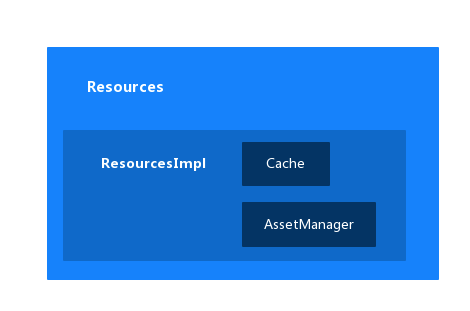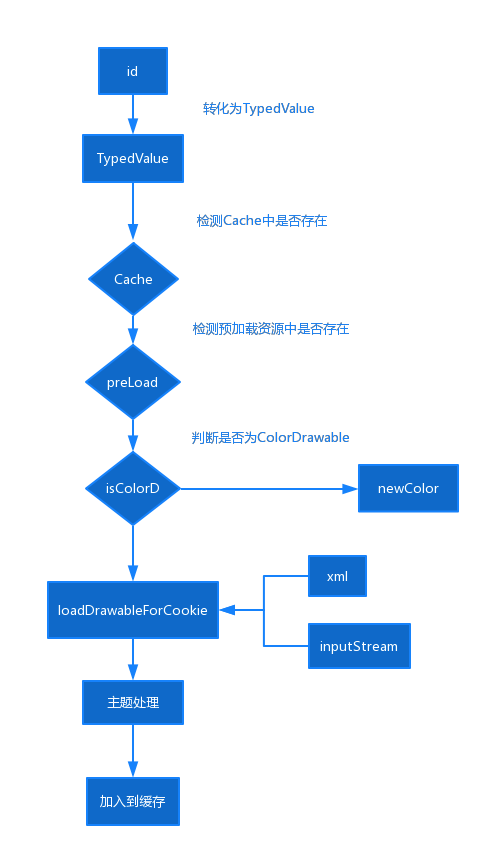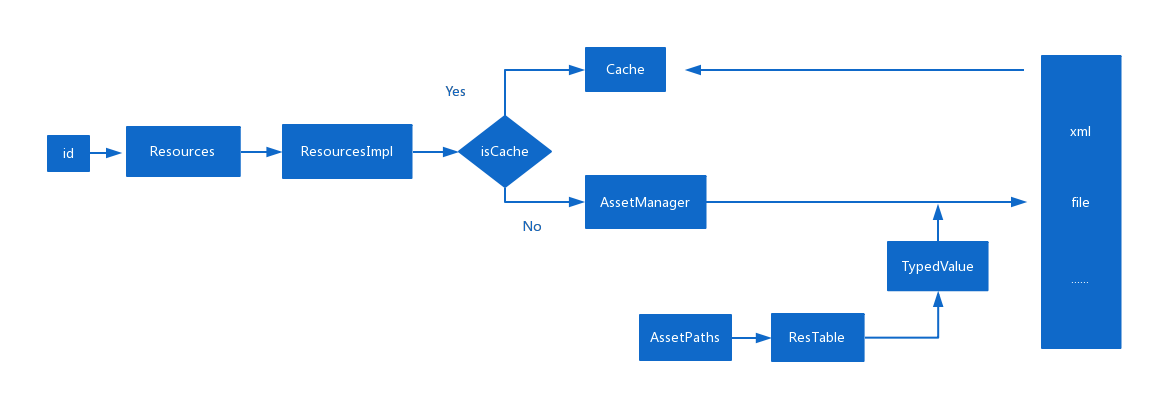前言
上一篇文章,讲到了Android中进程的启动和一个Activity的创建到显示流程,现在本篇要分析的是在Android中资源的装载机制,例如字符串资源,图片资源是如何被装载的。这里将从字符串和图片两种类型资源展开分析,同时对于后面所利用的资源装载的内容也会做简单的分析。
Resources源码剖析

对于资源的装载机制,这里核心的几个类是Resources,ResourcesImpl,AssetManager。Resources算是对于ResourcesImpl的一个代理,Resources的所有调用都是会调用到ResourcesImpl上,在ResourcesImpl的内部,具备对于资源的Cache和AssetManager,对于资源的装载会首先从其Cache中进行查找,当查找不到的时候,会调用AssetManager进行相应资源的装载,装载之后会在ResourcesImpl中将资源缓存下来。
Resource 中有一个内部静态变量
static Resources mSystem = null;
在getSystem方法中进行了初始化,作为对于内部变量的持有被保存着,其初次的调用是在zygote创建新进程的时候,预加载资源的时候被调用。
public static Resources getSystem() {
synchronized (sSync) {
Resources ret = mSystem;
if (ret == null) {
ret = new Resources();
mSystem = ret;
}
return ret;
}
}
Resrouce对象的创建,在Resrouce中的各种操作,最终真正的执行者是ResourcesImpl。
private Resources() {
this(null);
final DisplayMetrics metrics = new DisplayMetrics();
metrics.setToDefaults();
final Configuration config = new Configuration();
config.setToDefaults();
mResourcesImpl = new ResourcesImpl(AssetManager.getSystem(), metrics, config,
new DisplayAdjustments());
}
在Resources的构造函数中创建ResourcesImpl的实例。
public ResourcesImpl(@NonNull AssetManager assets, @Nullable DisplayMetrics metrics,
@Nullable Configuration config, @NonNull DisplayAdjustments displayAdjustments) {
mAssets = assets;
mMetrics.setToDefaults();
mDisplayAdjustments = displayAdjustments;
updateConfiguration(config, metrics, displayAdjustments.getCompatibilityInfo());
mAssets.ensureStringBlocks();
}
在创建ResoucesImpl实例的时候,获得了AssetManager的实例,其负责了应用层和资源文件的交互。Resource对象的获得,是通过ContextImpl方法中获得,获得方式是返回了其内部的变量mResource变量,
resources = mResourcesManager.getResources(
activityToken,
packageInfo.getResDir(),
packageInfo.getSplitResDirs(),
packageInfo.getOverlayDirs(),
packageInfo.getApplicationInfo().sharedLibraryFiles,
displayId,
overrideConfiguration,
compatInfo,
packageInfo.getClassLoader());
调用了ResourcesManager的getOrCreateResources方法。其实现为从activityResources中查找,如果查找不到,则会重新创建一个,然后加入到activityResources中,并返回。
获取字符串资源
从一个获取资源文件的方法看起,这里从一个获取文字的方法入手。
@NonNull public CharSequence getText(@StringRes int id) throws NotFoundException {
CharSequence res = mResourcesImpl.getAssets().getResourceText(id);
if (res != null) {
return res;
}
throw new NotFoundException("String resource ID #0x"
+ Integer.toHexString(id));
}
public AssetManager getAssets() {
return mAssets;
}
调用AssetManager的getResourceText
final CharSequence getResourceText(@StringRes int resId) {
synchronized (this) {
final TypedValue outValue = mValue;
if (getResourceValue(resId, 0, outValue, true)) {
return outValue.coerceToString();
}
return null;
}
}
首先根据id获得TypedValue,然后根据TypedValue获得我们需要的资源。
final boolean getResourceValue(@AnyRes int resId, int densityDpi, @NonNull TypedValue outValue,
boolean resolveRefs) {
final int block = loadResourceValue(resId, (short) densityDpi, outValue, resolveRefs);
if (block < 0) {
return false;
}
if (outValue.type == TypedValue.TYPE_STRING) {
outValue.string = mStringBlocks[block].get(outValue.data);
}
return true;
}
对于字符串资源,其值就存在TypedValue中,所以在获得了TypedValue之后,就可以通过其来获得资源值。
获取图片资源
由于图片资源的特殊性,相比于字符串资源的获取,要复杂一些,这里从上层的获取方法开始进行分析。
public Drawable getDrawable(@DrawableRes int id, @Nullable Theme theme)
throws NotFoundException {
final TypedValue value = obtainTempTypedValue();
try {
final ResourcesImpl impl = mResourcesImpl;
impl.getValue(id, value, true);
return impl.loadDrawable(this, value, id, theme, true);
} finally {
releaseTempTypedValue(value);
}
}
和对于字符串资源的装载类似,首先根据资源ID获取一个TypedValue对象,然后利用TypedValue实例,通过AssetManager进行装载。
void getValue(@AnyRes int id, TypedValue outValue, boolean resolveRefs)
throws NotFoundException {
boolean found = mAssets.getResourceValue(id, 0, outValue, resolveRefs);
if (found) {
return;
}
}
final boolean getResourceValue(@AnyRes int resId, int densityDpi, @NonNull TypedValue outValue,
boolean resolveRefs) {
final int block = loadResourceValue(resId, (short) densityDpi, outValue, resolveRefs);
if (block < 0) {
return false;
}
if (outValue.type == TypedValue.TYPE_STRING) {
outValue.string = mStringBlocks[block].get(outValue.data);
}
return true;
}
Drawable资源的获取核心代码是在对于ResourcesImpl的loadDrawable函数的调用。
@Nullable
Drawable loadDrawable(Resources wrapper, TypedValue value, int id, Resources.Theme theme,
boolean useCache) throws NotFoundException {
try {
if (TRACE_FOR_PRELOAD) {
if ((id >>> 24) == 0x1) {
final String name = getResourceName(id);
if (name != null) {
Log.d("PreloadDrawable", name);
}
}
}
//判断是否为ColorDrawable
final boolean isColorDrawable;
final DrawableCache caches;
final long key;
if (value.type >= TypedValue.TYPE_FIRST_COLOR_INT
&& value.type <= TypedValue.TYPE_LAST_COLOR_INT) {
isColorDrawable = true;
caches = mColorDrawableCache;
key = value.data;
} else {
isColorDrawable = false;
caches = mDrawableCache;
key = (((long) value.assetCookie) << 32) | value.data;
}
//,是否存在查找的Drawable
if (!mPreloading && useCache) {
final Drawable cachedDrawable = caches.getInstance(key, wrapper, theme);
if (cachedDrawable != null) {
return cachedDrawable;
}
}
// 检查预加载的资源文件中,是否存在要查找的Drawable
final Drawable.ConstantState cs;
if (isColorDrawable) {
cs = sPreloadedColorDrawables.get(key);
} else {
cs = sPreloadedDrawables[mConfiguration.getLayoutDirection()].get(key);
}
//创建Drawable
Drawable dr;
if (cs != null) {
dr = cs.newDrawable(wrapper);
} else if (isColorDrawable) {
dr = new ColorDrawable(value.data);
} else {
dr = loadDrawableForCookie(wrapper, value, id, null);
}
// 对Drawable的主题进行处理
final boolean canApplyTheme = dr != null && dr.canApplyTheme();
if (canApplyTheme && theme != null) {
dr = dr.mutate();
dr.applyTheme(theme);
dr.clearMutated();
}
// 将装载的Drawable资源加入到缓存之中
if (dr != null && useCache) {
dr.setChangingConfigurations(value.changingConfigurations);
cacheDrawable(value, isColorDrawable, caches, theme, canApplyTheme, key, dr);
}
return dr;
} catch (Exception e) {
...
}
}
loadDrawableForCookie
根据TypedValue中存储的信息,从XML文件或者资源流中构建Drawable
private Drawable loadDrawableForCookie(Resources wrapper, TypedValue value, int id,
Resources.Theme theme) {
if (value.string == null) {
throw new NotFoundException("Resource \"" + getResourceName(id) + "\" ("
+ Integer.toHexString(id) + ") is not a Drawable (color or path): " + value);
}
//解析值的文件名
final String file = value.string.toString();
if (TRACE_FOR_MISS_PRELOAD) {
// Log only framework resources
if ((id >>> 24) == 0x1) {
final String name = getResourceName(id);
if (name != null) {
Log.d(TAG, "Loading framework drawable #" + Integer.toHexString(id)
+ ": " + name + " at " + file);
}
}
}
final Drawable dr;
//如果文件后缀为xml,通过XmlResourceParser构建Drawable对象
try {
if (file.endsWith(".xml")) {
final XmlResourceParser rp = loadXmlResourceParser(
file, id, value.assetCookie, "drawable");
dr = Drawable.createFromXml(wrapper, rp, theme);
rp.close();
} else {
//从文件流中构建Drawable对象
final InputStream is = mAssets.openNonAsset(
value.assetCookie, file, AssetManager.ACCESS_STREAMING);
dr = Drawable.createFromResourceStream(wrapper, value, is, file, null);
is.close();
}
} catch (Exception e) {
...
}
return dr;
}
XmlResourceParser loadXmlResourceParser(@NonNull String file, @AnyRes int id, int assetCookie,
@NonNull String type)
throws NotFoundException {
if (id != 0) {
try {
synchronized (mCachedXmlBlocks) {
final int[] cachedXmlBlockCookies = mCachedXmlBlockCookies;
final String[] cachedXmlBlockFiles = mCachedXmlBlockFiles;
final XmlBlock[] cachedXmlBlocks = mCachedXmlBlocks;
// 检测缓存是否在我们需要的资源
final int num = cachedXmlBlockFiles.length;
for (int i = 0; i < num; i++) {
if (cachedXmlBlockCookies[i] == assetCookie && cachedXmlBlockFiles[i] != null
&& cachedXmlBlockFiles[i].equals(file)) {
return cachedXmlBlocks[i].newParser();
}
}
// 如果资源不在缓存之中,这通过AssetManager去装载,然后加入到缓存中
final XmlBlock block = mAssets.openXmlBlockAsset(assetCookie, file);
if (block != null) {
final int pos = (mLastCachedXmlBlockIndex + 1) % num;
mLastCachedXmlBlockIndex = pos;
final XmlBlock oldBlock = cachedXmlBlocks[pos];
if (oldBlock != null) {
oldBlock.close();
}
cachedXmlBlockCookies[pos] = assetCookie;
cachedXmlBlockFiles[pos] = file;
cachedXmlBlocks[pos] = block;
return block.newParser();
}
}
} catch (Exception e) {
....
}
}
}

图片资源的装载流程是首先将根据ID获得TypedValue实例,然后根据TypedValue进行查找Drawable资源,首先检测缓存中是否有该资源,如果没有从预加载资源中查找,如果预加载资源中也没有,判断要加载的资源类型,如果为colorDrawable,这根据Typedvalue进行创建,否则通过加载xml或者文件输入流进行处理来获得Drawable对象。
资源的装载分为两步,一个是通过资源ID得到ID对应的TypedValue对象,对于简单的资源,通过TypedValue即可,对于复杂的资源,需要第二步来把资源文件装载到内存之中。
AssetManager
在创建Resources的构造函数,创建ResourcesImpl的时候调用了AssetManager的getSystem方法,该方法用来确保创建唯一的AssetManager实例。
public static AssetManager getSystem() {
ensureSystemAssets();
return sSystem;
}
保证全局只有一个AssetManager
private static void ensureSystemAssets() {
synchronized (sSync) {
if (sSystem == null) {
AssetManager system = new AssetManager(true);
system.makeStringBlocks(null);
sSystem = system;
}
}
}
private AssetManager(boolean isSystem) {
if (DEBUG_REFS) {
synchronized (this) {
mNumRefs = 0;
incRefsLocked(this.hashCode());
}
}
init(true);
}
static void android_content_AssetManager_init(JNIEnv* env, jobject clazz, jboolean isSystem)
{
if (isSystem) {
verifySystemIdmaps();
}
AssetManager* am = new AssetManager();
if (am == NULL) {
jniThrowException(env, "java/lang/OutOfMemoryError", "");
return;
}
am->addDefaultAssets();
ALOGV("Created AssetManager %p for Java object %p\n", am, clazz);
env->SetLongField(clazz, gAssetManagerOffsets.mObject, reinterpret_cast<jlong>(am));
}
bool AssetManager::addDefaultAssets()
{
const char* root = getenv("ANDROID_ROOT");
LOG_ALWAYS_FATAL_IF(root == NULL, "ANDROID_ROOT not set");
String8 path(root);
path.appendPath(kSystemAssets);
return addAssetPath(path, NULL, false /* appAsLib */, true /* isSystemAsset */);
}
设置资源路径,通过对这个值的修改可以实现动态加载。
public final int addAssetPath(String path) {
return addAssetPathInternal(path, false);
}
private final int addAssetPathInternal(String path, boolean appAsLib) {
synchronized (this) {
int res = addAssetPathNative(path, appAsLib);
makeStringBlocks(mStringBlocks);
return res;
}
}
添加资源路径
bool AssetManager::addAssetPath(
const String8& path, int32_t* cookie, bool appAsLib, bool isSystemAsset)
{
AutoMutex _l(mLock);
asset_path ap;
String8 realPath(path);
if (kAppZipName) {
realPath.appendPath(kAppZipName);
}
ap.type = ::getFileType(realPath.string());
if (ap.type == kFileTypeRegular) {
ap.path = realPath;
} else {
ap.path = path;
ap.type = ::getFileType(path.string());
if (ap.type != kFileTypeDirectory && ap.type != kFileTypeRegular) {
ALOGW("Asset path %s is neither a directory nor file (type=%d).",
path.string(), (int)ap.type);
return false;
}
}
// Skip if we have it already.
for (size_t i=0; i<mAssetPaths.size(); i++) {
if (mAssetPaths[i].path == ap.path) {
if (cookie) {
*cookie = static_cast<int32_t>(i+1);
}
return true;
}
}
ALOGV("In %p Asset %s path: %s", this,
ap.type == kFileTypeDirectory ? "dir" : "zip", ap.path.string());
ap.isSystemAsset = isSystemAsset;
mAssetPaths.add(ap);
// new paths are always added at the end
if (cookie) {
*cookie = static_cast<int32_t>(mAssetPaths.size());
}
#ifdef __ANDROID__
// Load overlays, if any
asset_path oap;
for (size_t idx = 0; mZipSet.getOverlay(ap.path, idx, &oap); idx++) {
oap.isSystemAsset = isSystemAsset;
mAssetPaths.add(oap);
}
#endif
if (mResources != NULL) {
appendPathToResTable(ap, appAsLib);
}
return true;
}
APK文件中有一个文件resource.arsc。这个文件存放的是APK中资源的ID和资源类型,属性,文件名的读经关系表和所有的字符串,装载APK,就是解析该文件生成ResRTable对象,通过ResTable对象来解析资源ID。解压相应的路径,从中获得相应的资源表,然后加入到其中。每一次的调用都会调用,appendPathToResTable,将新增的路径的资源表添加到其中。
根据ID获取TypedValue
void getValue(@AnyRes int id, TypedValue outValue, boolean resolveRefs)
throws NotFoundException {
boolean found = mAssets.getResourceValue(id, 0, outValue, resolveRefs);
if (found) {
return;
}
throw new NotFoundException("Resource ID #0x" + Integer.toHexString(id));
}
final boolean getResourceValue(@AnyRes int resId, int densityDpi, @NonNull TypedValue outValue,
boolean resolveRefs) {
final int block = loadResourceValue(resId, (short) densityDpi, outValue, resolveRefs);
if (block < 0) {
return false;
}
if (outValue.type == TypedValue.TYPE_STRING) {
outValue.string = mStringBlocks[block].get(outValue.data);
}
return true;
}
从AssetManager中根据ID获取Value值。
static jint android_content_AssetManager_loadResourceValue(JNIEnv* env, jobject clazz,
jint ident,
jshort density,
jobject outValue,
jboolean resolve)
{
if (outValue == NULL) {
jniThrowNullPointerException(env, "outValue");
return 0;
}
AssetManager* am = assetManagerForJavaObject(env, clazz);
if (am == NULL) {
return 0;
}
const ResTable& res(am->getResources());
Res_value value;
ResTable_config config;
uint32_t typeSpecFlags;
ssize_t block = res.getResource(ident, &value, false, density, &typeSpecFlags, &config);
if (kThrowOnBadId) {
if (block == BAD_INDEX) {
jniThrowException(env, "java/lang/IllegalStateException", "Bad resource!");
return 0;
}
}
uint32_t ref = ident;
if (resolve) {
block = res.resolveReference(&value, block, &ref, &typeSpecFlags, &config);
if (kThrowOnBadId) {
if (block == BAD_INDEX) {
jniThrowException(env, "java/lang/IllegalStateException", "Bad resource!");
return 0;
}
}
}
if (block >= 0) {
return copyValue(env, outValue, &res, value, ref, block, typeSpecFlags, &config);
}
return static_cast<jint>(block);
}
对于资源的TypedValue的获取核心代码。
const ResTable& res(am->getResources());
ssize_t block = res.getResource(ident, &value, false, density, &typeSpecFlags, &config);
const ResTable& AssetManager::getResources(bool required) const
{
const ResTable* rt = getResTable(required);
return *rt;
}
根据AssetManager中设置的资源路径来查找资源Table
首先判断是否已经存在ResTable,如果不存在则创建,存在则会直接返回。然后根据路径去查找相应的Resources文件,然后将其转化为ResTable,方便后面的查找。
const ResTable* AssetManager::getResTable(bool required) const
{
ResTable* rt = mResources;
//已经存在
if (rt) {
return rt;
}
AutoMutex _l(mLock);
if (mResources != NULL) {
return mResources;
}
if (mCacheMode != CACHE_OFF && !mCacheValid) {
const_cast<AssetManager*>(this)->loadFileNameCacheLocked();
}
//创建ResTable
mResources = new ResTable();
updateResourceParamsLocked();
bool onlyEmptyResources = true;
const size_t N = mAssetPaths.size();
//遍历Asset路径,对于路径调用appendPathToResTable
for (size_t i=0; i<N; i++) {
bool empty = appendPathToResTable(mAssetPaths.itemAt(i));
onlyEmptyResources = onlyEmptyResources && empty;
}
//如果为空,则证明没有找到resources.arsc文件
if (required && onlyEmptyResources) {
ALOGW("Unable to find resources file resources.arsc");
delete mResources;
mResources = NULL;
}
return mResources;
}
Resources getTopLevelResources(String resDir, String[] splitResDirs, String[] overlayDirs,
String[] libDirs, int displayId, LoadedApk pkgInfo) {
return mResourcesManager.getResources(null, resDir, splitResDirs, overlayDirs, libDirs,
displayId, null, pkgInfo.getCompatibilityInfo(), pkgInfo.getClassLoader());
}
通过mResourcesManager获得Resources对象,如果不存在,则创建一个。
小结

对于资源的加载,大概可以通过上图进行概括,根据ID获取TypedValue,TypedValue的获取是在AssetManager添加资源路径的时候,通过对资源表的解析来构建的一个ResTable,通过该数据结构根据ID作为索引查找并构建TypedValue,然后再根据资源文件的类型,借助TypedValue内存储的关于资源的详细信息来获取资源,同时将加载的资源进行缓存。因此在插件化的方案中,通过创建新的Resource对象,为其添加新的Asset路径,从而构建出一个新的ResTable,实现通过ID进行非宿主App资源的装载。
补充:一个AssetManager对应了一个ResTable,没为AssetTable设置一个资源路径之后,都会对资源路径进行解析,将其中的资源读出来,所有加载的资源都会放置到该表之中,因此我们就可以对其来获取TypeValue,根据TypeValue来进行相应的资源的查找了。